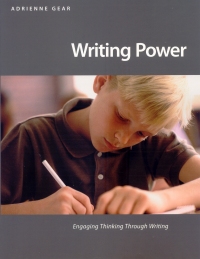| ________________
CM . . .
. Volume XVIIII Number 2. . . .September 14, 2012
excerpt:
Adrienne Gear provides teachers with a brief but informative history of writing instruction in her introductory chapter, referring to key researchers such as Donald Graves, Lucy Calkins and Ralph Fletcher who introduced us to “writing as a process;” followed by Hicks, Spandel and Culham who broke good writing down into traits. Gear explains the focus of her book is the missing piece of teaching writing – the “why” of writing. Teachers have used the Writing Process to teach the how of writing (planning, drafting, writing, revising, editing, and publishing) and the Writing Traits Model to teach the what of writing (ideas, organization, voice, word choice, sentence fluency and conventions). Writing Power adds another layer to teaching writing by providing lessons that teach students to examine why writers write, and to consider their readers as they write. To accomplish this goal, Gear directly connects her writing lessons to the reading lessons she provided in her book Reading Power (2006), using the same thinking/comprehension strategies – to connect, question, visualize, infer and transform, to provide the focus for her writing lessons. She invites her readers to move from the awareness of their own thinking (metacognition) to develop the awareness of the thinking of others. To accomplish this, she coins and defines a new term – alocognition. Other terms unique to Gear are “brain pockets” as the source for writing ideas and “walking” and “climbing” stories. Brain pockets are divided into memory, fact and imagination pockets and can be used to guide students to make various connections while reading and also to become the source of writing ideas. Walking stories describe an event and often include a repeating phrase, while climbing stories introduce the idea of a plot line and the elements of a story. The writing lessons in this book are for narrative writing – stories and a brief look at poetry. After clearly explaining her purpose, thinking and organizational structure that all her lessons are based on, Gear spends most of the book providing examples of lessons that teach technical tools for writing, and how to write so that your readers can connect, visualize, question, infer and have their thinking transformed. Lessons are based on realistic time frames, and topics are most often divided into four lessons that include planning, writing, conferencing and editing, and publishing and sharing. All lessons follow the identical format of reading a carefully selected picture book to illustrate the writing technique in the planning stage, supported with discussion suggestions, and Black Line Master (BLM) planning sheets. Lesson 2: Writing, includes teacher modelled writing, partner sharing of ideas and individual writing. Lesson 3: Conferencing and Editing is supported with primary and intermediate editing checklists and conferencing suggestions. Lesson 4: Publishing and Sharing is not always elaborated on, recognizing that not all writing is taken to this stage. The information provided assists teachers in adapting lessons to meet the needs of individual students. The suggested picture books for each lesson are identified as primary or intermediate; many samples of student writing from grades 1-7 are included; BLMs vary from story strips for emergent writers to a story box planner that includes six stages. Additional teaching supports include a weekly planning format, a BLM conference record sheet and writing assessment rubrics for grades 1-7. The scripted sequential lessons can provide support to novice teachers and experienced teachers with new ideas they can build on and adapt. Hopefully, all teachers will develop their own writing models and also will include visual and sensory experiences to spur their students on to write more, and more thoughtfully. The easy-to-read format of this book includes a comprehensive table of contents, wide left margins with quotes and space for the reader’s own notes, a detailed index and a list of professional resources for further reading. Writing Power is a companion book to Gear’s first two books – Reading Power and Nonfiction Reading Power. Gear effectively draws upon her many years of experience as a classroom teacher, librarian, mentor, and workshop facilitator to create a practical teacher resource. Gear has accomplished her goal, and now it is up to classroom teachers to teach their students to consider the what, how and why of writing – to become writers who are aware to how they are inviting their readers to think. Highly Recommended. Betty Klassen teaches in the Middle Years Program in the Faculty of Education at the University of Manitoba in Winnipeg, MB.
To comment
on this title or this review, send mail to cm@umanitoba.ca.
Copyright © the Manitoba Library Association. Reproduction for personal
use is permitted only if this copyright notice is maintained. Any
other reproduction is prohibited without permission.
NEXT REVIEW |
TABLE OF CONTENTS FOR THIS ISSUE
- September 14, 2012.
AUTHORS |
TITLES |
MEDIA REVIEWS |
PROFILES |
BACK ISSUES |
SEARCH |
CMARCHIVE |
HOME |
